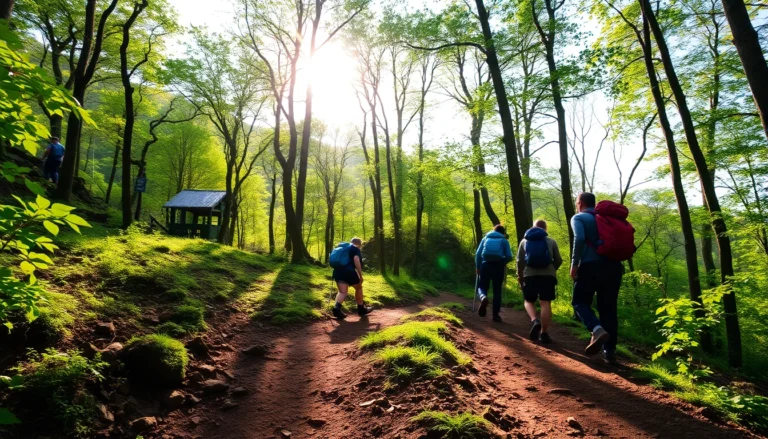
Introduction to Hiking in Indonesia: Nature, Adventure, and Benefits
Indonesia, with its sprawling archipelago and diverse landscapes, offers an unparalleled playground for outdoor enthusiasts. From towering volcanic peaks to lush jungles and pristine beaches, the country’s terrains are perfectly suited for various outdoor activities, particularly hiking. Engaging in hiking activities in Indonesia not only provides thrilling adventure opportunities but also promotes physical health, mental clarity, and emotional well-being. Whether you’re a seasoned trekker or a beginner eager to explore, understanding the essence of hiking in Indonesia can significantly enhance your experience and safety.
Beyond the scenic beauty, hiking in Indonesia connects you with local communities, cultural heritage, and environmental stewardship. As the popularity of outdoor recreation grows, so does the need for comprehensive knowledge about trail choices, preparation, techniques, and the myriad benefits this activity offers. This guide aims to serve as a detailed resource to help both novice and experienced hikers navigate Indonesia’s magnificent terrains confidently and responsibly.
Overview of Hiking Activities in Indonesia
Types of Hiking Explored in the Archipelago
Indonesia presents a myriad of hiking experiences catering to different interests and skill levels. Popular across regions are activities such as mountain trekking in Java and Bali, rainforest hikes in Sumatra, volcano summit climbs in Lombok, and coastal walks in Nusa Tenggara. These diverse environments offer various types of hikes:
- Volcano Trekking: Climbing active and dormant volcanoes like Mount Rinjani, Mount Bromo, and Mount Semeru. These hikes are often challenging and require planning, but reward climbers with breathtaking views and sense of accomplishment.
- Jungle and Rainforest Hiking: Exploring Indonesia’s dense rainforests offers wildlife sightings and immersion in lush ecosystems, essential for eco-tourism and adventure travel.
- Cultural and Heritage Trails: Combining hiking with cultural exploration, such as visiting traditional villages along mountain trails, enhances the travel experience.
Difficulty Levels and Trail Options
Hikes are categorized into easy, moderate, and challenging levels, accommodating beginners to seasoned hikers. For instance, the Bali Trekking routes offer gentle walks in rice terraces, while the Rinjani National Park’s summit hikes demand high endurance and technical skills. Properly assessing trail difficulty ensures safety and enjoyment, preventing over-exertion or hazards.
Why Outdoor Hiking Promotes Health and Well-being
Engaging in outdoor hiking in Indonesia provides physical exercise that boosts cardiovascular health, enhances muscular strength, and improves flexibility. Furthermore, exposure to natural environments has been scientifically linked to stress reduction, emotional stabilization, and mental rejuvenation. Diverse studies corroborate these health benefits, emphasizing hiking as a holistic activity that harmonizes physical and mental wellness.
Popular Hiking Destinations Across the Archipelago
Top destinations include Mount Rinjani (Lombok), Bromo Tengger Semeru National Park (Java), Mount Kerinci (Sumatra), and the Dieng Plateau (Java). These sites offer trail options for various skill levels and are accessible year-round, providing sustainable ecotourism opportunities while conserving Indonesia’s natural beauty.
Planning Your Hiking Journey: Preparation and Safety Tips
Choosing the Right Trails and Difficulty Levels
Selecting an appropriate trail depends on your fitness level, experience, and the type of adventure you seek. Resources such as local guides, trail maps, and online communities are invaluable for research. For beginners, starting with well-marked, shorter, and flat routes minimizes risks, while experienced hikers may opt for multi-day, rugged paths requiring additional planning.
Essential Equipment and Gear for Hikers
Gear selection is critical for safety and comfort. Basic equipment includes sturdy hiking shoes or boots, weather-appropriate clothing, a backpack with enough capacity, navigation tools (compass, maps, GPS), sufficient water, high-energy snacks, and a first aid kit. Specialized gear such as hiking poles, headlamps, and layered clothing enhances performance, especially in variable climates.
Safety Precautions and Environmental Considerations
Precautionary measures encompass informing someone about your itinerary, checking weather conditions, and carrying communication devices such as a charged mobile phone or satellite phone in remote areas. Respect environmental guidelines—stay on designated trails, avoid littering, and do not disturb wildlife. Be aware of local hazards like volcanic activity, sudden weather changes, and wildlife encounters. Striving for minimal ecological impact preserves Indonesia’s fragile ecosystems for future generations.
Hiking Techniques and Best Practices for All Levels
Proper Walking Techniques and Pace Management
Maintaining an efficient walking pace involves consistency, proper stride, and mindful breathing. For beginners, a pace that allows steady breathing and comfortable movement reduces fatigue. Use techniques such as heel-to-toe walking, engaging core muscles, and short steps on challenging terrain. Practicing pacing helps conserve energy over extended hikes.
Navigation Skills and Trail Markers
Strong navigation skills are essential, especially in remote or poorly marked areas. Understanding topographical maps, compass use, and GPS navigation ensures you stay on course. Recognize trail markers, cairns, and natural landmarks. Always have a backup plan if faced with unexpected trail detours or obstacles.
Hydration, Nutrition, and Mental Preparedness
Staying hydrated is crucial; carry sufficient water and replenish regularly. Nutritional snacks like nuts, dried fruit, energy bars, and electro-lite drinks boost stamina. Mentally, preparing for challenges fosters resilience—practice mindfulness, set realistic expectations, and cultivate patience to enjoy each moment fully.
Understanding the Differences: Hiking, Trekking, and Backpacking
Definitions and Key Distinctions in Outdoor Activities
Although often used interchangeably, hiking, trekking, and backpacking represent different levels of outdoor engagement. Hiking typically involves short, day trips on maintained trails. Trekking extends beyond, involving multi-day journeys through more rugged terrain, with varied accommodations or camping. Backpacking combines hiking with wilderness camping, requiring more gear and logistical planning.
When to Choose Hiking Over Trekking or Backpacking
For those new to outdoor activities or seeking casual recreation, day hiking is ideal. Experienced adventurers enjoy trekking for longer challenges, exploring remote regions of Indonesia like the jungles of Sumatra or the Carstensz Pyramid in Papua. Backpacking suits those desiring immersive wilderness experiences, often over several days or weeks.
Adapting Your Approach for Different Terrains and Durations
Adjust gear, pace, and preparation according to terrain and trip length. Sharp inclines, loose rocks, or dense forests demand technical skills and appropriate equipment. Longer durations require logistical planning—food, shelter, and safety measures—ensuring a sustainable and enjoyable trek.
Maximizing Benefits and Enjoying Your Hiking Experience
Physical, Mental, and Emotional Health Advantages
Regular hiking enhances cardiovascular health, muscle strength, and joint mobility. Concurrently, exposure to nature reduces cortisol levels, alleviates anxiety, and improves mood. The sense of achievement from overcoming challenging trails fosters confidence. Additionally, outdoor activities encourage mindfulness, helping clear mental clutter and improve focus.
Capturing Moments: Photography and Outdoor Journaling
Documenting your journey through photography or journaling enriches the experience. Indonesia’s vibrant landscapes, unique flora and fauna, and cultural encounters provide compelling imagery. Use durable equipment suited to outdoor conditions and practice ethical photography—respect wildlife and local communities.
Connecting with Local Communities and Sustainable Practices
Engaging with local inhabitants enhances cultural understanding and supports regional economies. Participate in community-led eco-tourism initiatives, abide by responsible travel guidelines, and minimize ecological footprints. Promoting sustainable hiking practices ensures preservation of Indonesia’s natural and cultural heritage.
Conclusion
Embarking on hikes across Indonesia unlocks an enriching tapestry of natural wonders and personal growth. With meticulous planning, respect for the environment, and a spirit of adventure, hikers can enjoy safe, rewarding journeys that contribute to well-being and environmental sustainability. As Indonesia continues to beckon outdoor explorers, embracing a responsible and informed approach promises memorable adventures that leave lasting positive impacts—both on you and the breathtaking landscapes you explore.



